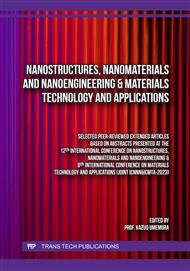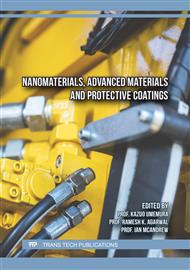[1]
M. Tsukada, M.M.R. Khan, T. Tanaka, and H. Morikawa: Thermal characteristics and physical properties of silk fabrics grafted with phosphorous flame retardant agents. Textile Research Journal. Vol. 81(15) (2011), pp.1541-1548
DOI: 10.1177/0040517511407376
Google Scholar
[2]
BA. Çakır, L. Budama, Ö. Topel and N. Hoda: Synthesis of ZnO nanoparticles using PS-b-PAA reverse micelle cores for UV protective, self-cleaning and antibacterial textile applications. Colloids and Surfaces A: Physicochemical and Engineering Aspects. Vol. 414 (2012), pp.132-139
DOI: 10.1016/j.colsurfa.2012.08.015
Google Scholar
[3]
C.K. Simi and T.E. Abraham: Transparent xyloglucan–chitosan complex hydrogels for different applications. Food Hydrocolloids. Vol. 24(1) (2010), pp.72-80. https://doi.org/
DOI: 10.1016/j.foodhyd.2009.08.007
Google Scholar
[4]
H. Chen, X. Hu, E. Chen, S. Wu, D.J. McClements, S. Liu, B. Li, and Y. Li: Preparation, characterization, and properties of chitosan films with cinnamaldehyde nanoemulsions. Food Hydrocolloids. Vol. 61 (2016), pp.662-671
DOI: 10.1016/j.foodhyd.2016.06.034
Google Scholar
[5]
L. Lopez, W.A. Daoud, and D. Dutta: Preparation of large scale photocatalytic TiO2 films by the sol–gel process. Surface and Coatings Technology. Vol. 205(2) (2010), pp.251-257
DOI: 10.1016/j.surfcoat.2010.06.028
Google Scholar
[6]
B. Sharma, M. Jassal, A.K. Agrawal, N. Goyal, and D. Rastogi: Development of a quantitative assessment method for self-cleaning by photocatalytic degradation of stains on cotton. Indian Journal of Fibre & Textile Research. Vol. 37 (2012), pp.74-82
Google Scholar
[7]
R. Benedix, F. Dehn, J. Quaas, and M. Orgass: Application of titanium dioxide photocatalysis to create self-cleaning building materials. Lacer. Vol. 5 (2000), pp.157-168
Google Scholar
[8]
A.A. Ashkarran, H. Hamidinezhad, H. Haddadi and M. Mahmoudi: Double-doped TiO2 nanoparticles as an efficient visible-light-active photocatalyst and antibacterial agent under solar simulated light. Applied Surface Science. Vol. 301 (2014), pp.338-345
DOI: 10.1016/j.apsusc.2014.02.074
Google Scholar
[9]
M. Pelaez, N.T. Nolan, S.C. Pillai, M.K. Seery, P. Falaras, A.G. Kontos, P.S.M. Dunlop, J.W.J. Hamilton, J.A. Byrne, K. O'Shea, M.H. Entezari and DD. Dionysiou: A review on the visible light active titanium dioxide photocatalysts for environmental applications. Applied Catalysis B: Environmental. Vol. 125 (2012), pp.331-349
DOI: 10.1016/j.apcatb.2012.05.036
Google Scholar
[10]
M. Catauro, E. Tranquillo, G. Dal Poggetto, M. Pasquali, A. Dell'Era and S. Vecchio Ciprioti: Influence of the Heat Treatment on the Particles Size and on the Crystalline Phase of TiO2 Synthesized by the Sol-Gel Method. Materials. Vol. 11(12) (2018), p.2364
DOI: 10.3390/ma11122364
Google Scholar
[11]
International Organization for Standardization, Joint ISO/CIE Standard: Colorimetry—Part 4: CIE 1976 L*a*b* Colour Space; ISO 11664-4:2008(E)/CIE S014-4/E:2007; ISO: Geneva, Switzerland, (2007)
DOI: 10.25039/ds11664-4.2019
Google Scholar
[12]
AK Inamdar, N.R. Hulsure, AS Kadam, R.S. Rajenimbalkar, R. Karpoormath, S.B. Shelke, and SN Inamdar: Flame synthesized tetragonal TiO2 nanoparticles for Methylene Blue and Congo Red dye removal applications. Results in Chemistry. Vol. 5 (2023), p.100854
DOI: 10.1016/j.rechem.2023.100854
Google Scholar
[13]
N.V. Padaki, B. Das and A. Basu, in 1 - Advances in understanding the properties of Silk, edited by A. Basu, Advances in Silk Science and Technology, Woodhead Publishing (2015)
DOI: 10.1016/b978-1-78242-311-9.00001-x
Google Scholar
[14]
X. Yang, Z. Wang, Y. Zhang, and W. Liu: A Biocompatible and Sustainable Anti-ultraviolet Functionalization of Cotton Fabric with Nanocellulose and Chitosan Nanocomposites. Fibers and Polymers. Vol. 21(11) (2020), pp.2521-2529
DOI: 10.1007/s12221-020-1339-x
Google Scholar



